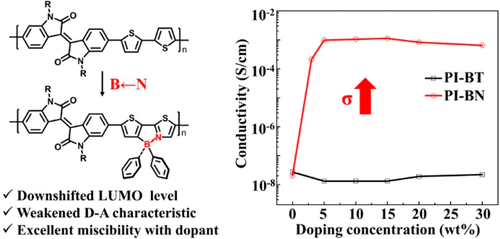当前位置:
X-MOL 学术
›
ACS Appl. Mater. Interfaces
›
论文详情
Our official English website, www.x-mol.net, welcomes your
feedback! (Note: you will need to create a separate account there.)
B ← N Unit Enables n-Doping of Conjugated Polymers for Thermoelectric Application.
ACS Applied Materials & Interfaces ( IF 8.3 ) Pub Date : 2020-02-14 , DOI: 10.1021/acsami.9b21527 Changshuai Dong 1, 2 , Bin Meng 1 , Jun Liu 1, 2 , Lixiang Wang 1, 2
ACS Applied Materials & Interfaces ( IF 8.3 ) Pub Date : 2020-02-14 , DOI: 10.1021/acsami.9b21527 Changshuai Dong 1, 2 , Bin Meng 1 , Jun Liu 1, 2 , Lixiang Wang 1, 2
Affiliation

|
Only very few conjugated polymers can be n-doped for thermoelectric applications. In this work, for the first time, we report that incorporation of Boron-Nitrogen coordination bond (B ← N unit) to a donor-acceptor (D-A) type conjugated polymer enable n-doping for thermoelectric application. The incorporation of B ← N unit into the polymer backbone leads to not only a downshift of LUMO/HOMO energy levels by 0.27 eV/0.33 eV, but also diminished intramolecular D-A character of the polymer backbone. As a result, while the control polymer cannot be n-doped, the polymer containing B ← N unit (PI-BN) can be n-doped by 4-(1,3-dimethyl-2,3-dihydro-1H-benzoimidazol-2-yl)-N,N-dimethylaniline (N-DMBI). Finally, PI-BN exhibits an electrical conductivity (σ) of 0.97 × 10-3 S cm-1, Seebeck coefficient (S) of -453.8 μV K-1, and power factor (PF) of 0.02 μW m-1 K-2 when doped with 5 wt % N-DMBI. A great advantage of PI-BN is its excellent miscibility with the n-dopant because of its amorphous nature and large pendent substituents. This work indicates that organoboron polymers can be n-doped and can be used for thermoelectrics.
中文翻译:

B←N单元可对热电应用中的共轭聚合物进行n掺杂。
对于热电应用,只有极少数的共轭聚合物可以进行n掺杂。在这项工作中,我们首次报道硼与氮的配位键(B←N单元)与施主-受主(DA)型共轭聚合物的结合能够为热电应用实现n掺杂。B←N单元掺入聚合物主链不仅导致LUMO / HOMO能级降低0.27 eV / 0.33 eV,而且导致聚合物主链的分子内DA特性降低。结果,虽然对照聚合物不能被n-掺杂,但是含有B←N单元的聚合物(PI-BN)可以被4-(1,3-二甲基-2,3-二氢-1H-苯并咪唑)n-掺杂。 -2-基)-N,N-二甲基苯胺(N-DMBI)。最后,PI-BN的电导率(σ)为0.97×10-3 S cm-1,塞贝克系数(S)为-453.8μVK-1,功率因数(PF)为0。掺杂5 wt%N-DMBI时为02μWm-1 K-2。PI-BN的一大优势是其与n型掺杂剂的优异混溶性,因为它具有无定形性质和较大的侧基取代基。这项工作表明有机硼聚合物可以被n掺杂,并可以用于热电学。
更新日期:2020-02-23
中文翻译:

B←N单元可对热电应用中的共轭聚合物进行n掺杂。
对于热电应用,只有极少数的共轭聚合物可以进行n掺杂。在这项工作中,我们首次报道硼与氮的配位键(B←N单元)与施主-受主(DA)型共轭聚合物的结合能够为热电应用实现n掺杂。B←N单元掺入聚合物主链不仅导致LUMO / HOMO能级降低0.27 eV / 0.33 eV,而且导致聚合物主链的分子内DA特性降低。结果,虽然对照聚合物不能被n-掺杂,但是含有B←N单元的聚合物(PI-BN)可以被4-(1,3-二甲基-2,3-二氢-1H-苯并咪唑)n-掺杂。 -2-基)-N,N-二甲基苯胺(N-DMBI)。最后,PI-BN的电导率(σ)为0.97×10-3 S cm-1,塞贝克系数(S)为-453.8μVK-1,功率因数(PF)为0。掺杂5 wt%N-DMBI时为02μWm-1 K-2。PI-BN的一大优势是其与n型掺杂剂的优异混溶性,因为它具有无定形性质和较大的侧基取代基。这项工作表明有机硼聚合物可以被n掺杂,并可以用于热电学。













































 京公网安备 11010802027423号
京公网安备 11010802027423号